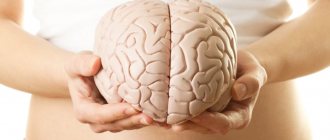14.01.2021
Over the years, a person accumulates more and more diseases. Many people approach old age with a whole “bouquet” of ailments, some of which cannot be cured or even predicted. This includes Parkinson's disease.
Its development does not depend on a person’s intellectual abilities. Even such gifted individuals as Salvador Dali suffered from Parkinsonism. Doctors still find it difficult to answer why it occurs. And yet there are methods to combat this serious disease.
Symptoms of the disease
Parkinsonism is a chronic disease of the central nervous system. The British James Parkinson described in detail and laid the foundations for its diagnosis. He found that the disease is the result of a lack of dopamine in the body, a neurotransmitter produced by the cerebral cortex.
The first signs of the problem usually appear after age 50. Parkinsonism is a neurodegenerative disease that progresses with age. The older a person gets, the more severe the symptoms become.
Signs of the disease:
- It becomes difficult for a person to navigate in space.
- There is tremor - trembling - of the limbs.
- There are difficulties with coordination.
- The patient's movements gradually become slower.
- In older people, the disease can take two forms. In the primary case, we are talking about Parkinson's disease itself, caused by heredity. The secondary form occurs against the background of worsening other diseases (Parkinson's syndrome).
The disease can be recognized in an elderly person by the following symptoms:
- Tremor. First, the patient's head begins to sway periodically. Then the trembling moves to the lower lip, arms, legs. Tremor is especially noticeable when a person does not move or is at rest. It becomes difficult for the patient to hold even light objects in his hands.
- Slowness of movements (in medical terminology - hypokinesia). Over time, a person suffering from Parkinson's seems to slow down. The range of movements of his arms and legs is significantly reduced. This also affects facial expressions.
- Rigidity. Elderly patients with Parkinsonism lose muscle tone. Often the degenerative process also affects the joints.
- Loss of sense of balance. Loss of orientation, instability, and frequent falls are the sad companions of Parkinson's disease.
There are several forms of the disease. In 40% of cases, doctors diagnose the trembling-rigid form, the most striking sign of which is tremor. 30% of patients suffer from slowness of movement. Trembling of the limbs is rare.
In 20%, a rigid-trembling form of the disease is diagnosed. With it, patients experience difficulties with coordination. In other cases, a trembling or akinetic form is observed. With the first, patients suffer from muscle tone, facial expressions, and severe tremor. With the second, the symptoms are almost invisible.
PsyAndNeuro.ru
A week ago, we published a review of the article by Sommer I. et al “Towards a personalized treatment of hallucinations”, in which the authors identified 3 main mechanisms for the development of perceptual deceptions (decreased cholinergic neurotransmission, increased dopamine synthesis and deafferentation), on which further patient management tactics depend. In another earlier article, published in the journal Schizophrenia Bulletin, the same authors examine the evidence base for treatments for hallucinations in schizophrenia and other mental and nervous disorders. This article is more focused on clinical practice, thereby organically complementing the latter - which largely considers the fundamental aspects of hallucinations and the psychopharmacological effects on them. Below are the main points of the article “The Treatment of Hallucinations in Schizophrenia Spectrum Disorders”.
Hallucinations can occur in the context of many disorders and syndromes. Therefore, the choice of treatment depends not only on the type of perceptual deceptions and the impact on daily functioning, but also on the underlying disorder. At times, it can be very difficult to determine the underlying disorder, since hallucinations, for example, in borderline personality disorder, psychotic depression or temporal lobe epilepsy, may be indistinguishable from hallucinations in schizophrenia at the phenomenological level.
Associated symptoms such as paroxysmal activity, parkinsonian motor symptoms, and loss of vision or hearing are the most reliable signs used in the differential diagnosis. Some people who only hallucinate sporadically may simply be concerned that their experience is a sign of a mental disorder, without being concerned about the hallucinations themselves. For others, the burden of hallucinations may not outweigh the side effects of their treatment. As a result, treatment may not be applicable in all cases. This article will look at some of the errors that are often associated with hallucinations, as well as specific treatment options for them.
Schizophrenia can be accompanied by hallucinations in any sensory modality. In 70% of cases they are auditory in nature, and in 50% of cases visual hallucinations are observed. Other types of hallucinations are less common.
The only type of medications known to be successfully used to treat hallucinations in schizophrenia are antipsychotics. Only 8% of first-episode psychotic patients still experience hallucinations after 1 year of treatment. However, to date, no clinical studies have been published that compare the effectiveness of different antipsychotic drugs for a single and specific indication: hallucinations. Therefore, the analysis used data from the European First Episode Psychotic Study, which assessed the effectiveness of 5 antipsychotic drugs in the treatment of hallucinations. Olanzapine, amisulpride, ziprasidone, and quetiapine were found to be equally effective against hallucinations; haloperidol, according to the study authors, cannot be the drug of first choice.
If the first choice drug does not provide improvement, it is best to switch to another drug after 2-4 weeks of treatment. Clozapine is the drug of choice for patients who are refractory to two adequate courses of antipsychotic medications. To prevent relapse, treatment should be continued with the same antipsychotic and, preferably, at the same dose. Long-acting formulations should be considered for all patients because the risk of non-compliance is very high.
Cognitive behavioral therapy (CBT) may be used in addition to antipsychotic therapy. CBT is aimed at reducing the emotional distress associated with auditory hallucinations, it teaches the patient to ignore the “voices” and focus on future plans and goals, which affects the quality of life of the patients. However, CBT had no effect on the frequency of hallucinations.
On the other hand, transcranial magnetic stimulation (TMS) can reduce the frequency and severity of auditory hallucinations. Several meta-analyses have demonstrated efficacy for low-frequency repetitive TMS of the left temporoparietal region compared with placebo. As a consequence, TMS now has the status of a potentially useful treatment for auditory hallucinations, but only in combination with modern antipsychotic therapy.
Several guidelines mention electroconvulsive therapy (ECT) as the final step in the treatment of treatment-resistant psychoses within schizophrenia. Although several studies have shown clinical improvement following the use of ECT, specific reductions in hallucination severity have never been assessed at the group level.
Delirium is an acute neuropsychiatric syndrome characterized by psychotic symptoms such as hallucinations and delusions in the presence of decreased attention, fluctuations in consciousness and other cognitive functions. This condition is very common in patients admitted to intensive care units, with an incidence of 32%, and is notably associated with a poor prognosis and increased mortality.
The only etiological treatment for delirium is to improve the patient's physical condition. Symptomatic treatment of hallucinations and other symptoms of delirium should begin with measures aimed at normalizing the patient's circadian rhythm and orientation. Pharmacological treatment should preferably consist of haloperidol or olanzapine, as recommended in the latest NICE guidelines. Although benzodiazepines are widely used to treat delirium, their use is recommended only for alcoholic delirium. Cholinesterase inhibitors are not recommended, as evidenced by a randomized clinical trial of rivastigmine in patients with delirium admitted to the intensive care unit. This study was stopped early due to a significant increase in mortality and duration of delirium compared with the control group.
The prevalence of hallucinations and other psychotic symptoms among patients with PD is 80%. In the case of dementia with Lewy bodies, which is pathogenetically closely related to PD, these numbers are even higher, especially for visual hallucinations. Auditory hallucinations are present in 20% of cases.
The pathophysiology of psychosis in PD and dementia with Lewy bodies involves a complex interaction of environmental and disease-related factors, including central dopaminergic activity, imbalance of the dopaminergic and cholinergic neurotransmitter systems, dysfunction of the visual pathways, changes in the regulation of the sleep-wake cycle, and impaired attentional focus. However, the most important external factor in the development of hallucinations within PD is drug treatment.
Treatment strategies: decrease antiparkinsonian medications, increase low-dose “atypical” antipsychotics, and possibly cholinesterase inhibitors. Eng and Welty reviewed 13 studies of antipsychotic treatment in patients with PD and concluded that long-term therapy with clozapine is indeed effective, while results from studies using quetiapine are inconsistent. Only one double-blind, placebo-controlled trial involving 188 patients with PD and hallucinations supports the effectiveness of the cholinesterase inhibitor rivastigmine. Thus, although the use of cholinesterase inhibitors, especially rivastigmine, appears to be a promising treatment for hallucinations in PD, these studies support the use of clozapine alone.
In AD, the occurrence of psychosis in 30–50% of cases has serious consequences for both patients and caregivers. Cholinesterase inhibitors such as donepezil may have a beneficial effect on hallucinations with a relatively mild side effect profile. Another study on the treatment of psychosis in AD examined the effectiveness of olanzapine, quetiapine, risperidone and placebo over 36 weeks. The results showed that risperidone was more effective than the other two drugs and placebo. However, these drugs should be taken with caution due to the increased risk of complications in elderly patients.
As a consequence, it is strongly recommended not to consider antipsychotic drugs as a first choice for the treatment of psychotic symptoms in AD. Extrapyramidal symptoms and arrhythmias due to QT prolongation are common complications of “typical” antipsychotic drugs, while various cerebrovascular pathologies occur more often with the use of “atypical” antipsychotics. However, these medications should be used when the severity of symptoms is extreme or when symptoms do not respond to other types of medications or nonpharmacologic interventions.
The reported incidence of hallucinations and other psychotic symptoms in epilepsy is 3.3%, and in temporal lobe epilepsy it is as high as 14%. Hallucinations may occur shortly before (aura), during, or after an epileptic seizure, but often occur independently of any motor seizures. Hallucinations often resemble those found in patients diagnosed with schizophrenia and are referred to as “schizophrenic psychoses of epilepsy.”
Treatment of hallucinations should primarily involve minimizing any drug that may mediate these symptoms. Various antiepileptic drugs, such as phenobarbital, zonisamide, levetiracetam and gabapentin, are known to induce hallucinations. In such cases, reducing the dose or switching to another antiepileptic drug can lead to relatively rapid relief of hallucinations.
When antiepileptic drugs cannot be reduced or discontinued, antipsychotics are the drugs of choice. Clozapine and chlorpromazine should be avoided due to their epileptogenic properties, while quetiapine, risperidone and haloperidol are generally well tolerated.
Patients with low vision may experience complex visual hallucinations, a condition known as Charles Bonnet syndrome. Likewise, people with progressive hearing loss may develop auditory hallucinations of music, voices, or other sounds.
It is believed that such hallucinations are actually phenomena due to deafferentation of areas of the visual or auditory association cortex of the brain, which can lead to so-called “phantom perceptions.” Cognitive defects and social isolation may act as additional risk factors.
Patients who understand their unrealistic nature tend to suffer less from them, although they may still be distressed by the fear of "inevitable madness." Reassurance and explanation that visual or auditory deceptions do not imply any mental disorder can have a powerful therapeutic effect.
According to the authors, psychotropic treatment is not always necessary, since relief of hallucinations may cease either spontaneously or after the cessation of social isolation. The first choice of treatment is restoration of vision or hearing, for example through cataract surgery, external ear cleaning or hearing aids.
When such interventions are unsuccessful, pharmacological treatment may be considered, although the benefits of treatment do not always outweigh the disadvantages of side effects. Although antipsychotics, antiepileptic drugs, and cholinesterase inhibitors have previously been reported to be effective in these settings, there are currently no randomized studies of the effectiveness of these types of medications in patients with hallucinations as part of sensory deafferentation. If pharmacological treatment is considered necessary, quetiapine or lamotrigine may be the drugs of choice. TMS has also been used for this type of hallucination, but the results remain inconclusive.
The material was prepared as part of the ProSchizophrenia project - a specialized section of the official website of the Russian Society of Psychiatrists, dedicated to schizophrenia, modern approaches to its diagnosis and treatment.
Prepared by: Kasyanov E.D.
Source: Sommer I. et al The Treatment of Hallucinations in Schizophrenia Spectrum Disorders. Schizophrenia Bulletin, Volume 38, Issue 4, 18 June 2012, Pages 704–714, https://doi.org/10.1093/schbul/sbs034
Dear reader, in gratitude, you can financially support our project or specifically the author of this article by writing his name in the cover letter of the money transfer.
Such support is currently the only way to develop our project.
Sberbank – 5469 5500 1827 1533 YandexMoney – 410011063875586 Sberbank – 5469 5500 1827 1533 YandexMoney – 410011063875586 Sberbank – 5469 5500 1827 1533 YandexMoney – 410011063875586
Causes of the disease
There are 3 main provoking factors:
1. Changes in cells.
Human motor activity is completely subordinated to the work of the brain. It is primarily influenced by the neurotransmitter dopamine. The less of it there is in the body - and with age, the production of dopamine decreases - the worse the body coordinates its actions.
A decrease in physical activity is observed in almost all older people. However, in citizens who are not susceptible to Parkinson's disease, it begins much later. In sick people, symptoms appear early and get worse every year.
The number of dopamine-containing cells in them decreases sharply.
This process develops rapidly, gradually leading a person to complete helplessness and disability. 2. Heredity.
Parkinson's disease is a “gift” from our ancestors.
If the parents had it, then the offspring are twice as likely to encounter the same problems in old age. The tendency to degenerative processes of the central nervous system is inherent in genes. 3. The influence of negative factors.
The development of the disease in older people is also due to the fact that the areas of the brain that produce dopamine are very sensitive to negative factors. Parkinson's disease can be triggered by:
- encephalopathy;
- taking antipsychotics and other drugs used in psychiatry;
- heart attack;
- cerebral atherosclerosis;
- encephalitis;
- neoplasms in brain tissue;
- severe head injuries;
- poisoning with chemicals and drugs, alcohol, carbon monoxide.
If the disease develops against the background of these factors, then they speak of secondary parkinsonism. Whatever the reasons, the disease always greatly complicates the life of the elderly. Due to the fact that a person cannot move freely, he becomes less socially active. Isolation and loneliness also have a negative impact on mental health.
Depression and limited movement make a person vulnerable to various illnesses. Patients with Parkinson's are prone to infectious and viral diseases, and due to poor coordination they also regularly suffer injuries. Naturally, a person with such a list of problems needs constant help.
Causes of Parkinson's development
In fact, in the brain of every person, to some extent, neurons are doomed to death, which is a completely natural process for physiology. Experts have even calculated the pattern of loss of nerve cells in the brain in absolutely all people: over 10 years of life, approximately 4% of neurons die irrevocably. But the brain is unique because it can “turn on” peculiar compensatory mechanisms in order to maintain the normal functioning of the nervous system.
If the compensation potentials have dried up, and at the same time the extrapyramidal system (which includes the substantia nigra, etc.) has lost 80% of its neurons, symptoms typical of Parkinson’s disease arise. That is, in an abnormal position, the destruction of the corresponding type of neurons occurs more actively. And the older the person, the higher the likelihood of reaching the threshold level. Doctors hypothesize that the disease is associated with an increase in life expectancy, since the disease predominantly affects the elderly group.
In Parkinson's disease, a more intense decrease in the number of neurons than in normal aging physiology begins long before the onset of the main symptoms. And only decades later, when a person reaches old age, he realizes that he is sick.
Specifically, PD is classified as an idiopathic form, which indicates an independent (primary) disease that occurs for unexplained reasons. It follows that it is not associated with genetic factors or any other diseases. When examining a patient, doctors cannot determine the etiology of its development.
In medicine, there is another term - “parkinsonism”. Parkinsonism is a general concept that characterizes the syndrome as a whole, which is associated with lesions of the extrapyramidal system of primary or secondary origin. Unlike the primary form (true PD), secondary parkinsonism has an underlying cause that leads to the same clinical outcome. The root causes of secondary parkinsonism may be:
- intoxication of the body under the toxic effects of carbon monoxide, manganese, barbiturates, MPPT neurotoxin, cinnarizine, nicotine, etc.;
- chronic encephalitis;
- traumatic brain injuries;
- encephalopathy;
- cerebral atherosclerosis;
- cerebral stroke;
- brain tumors;
- heredity (family mutation of the α-synuclein and parkin genes).
Based on clinical data, in 3/4 of cases of parkinsonism syndrome, it is Parkinson’s disease that is detected, that is, the idiopathic (including juvenile) form.
Manifestations of Parkinson's disease
There are 2 types of signs. The first includes all the symptoms that were described earlier: hypokinesia, tremor, etc. Decreased motor activity is one of the most severe “companions” of the disease.
In a healthy person, the urge to do something is immediately reinforced by the readiness of the muscles. The vast majority of movements - walking, running, etc. - are performed involuntarily, immediately, without any prior preparation. A healthy person walks without thinking about the fact that he needs to lift his leg, move it to a new place and lower it.
The patient’s muscles poorly perceive nerve impulses, so a fairly noticeable period of time passes between the impulse and the action itself. Parkinson's disease affects walking, head and arm movements, even facial expressions. Facial muscles, having lost their tone, almost do not reflect the patient’s true emotions. From the outside it seems that he doesn’t care.
Decreased motor activity manifests itself in different ways. Sometimes patients simply freeze, and in rather uncomfortable positions. Handwriting also changes. An elderly person begins to write more slowly and does it with noticeable effort.
The patient’s muscles that flex and extend the limbs work simultaneously, so the body is constantly in good shape. The patient himself clearly feels this condition. People with developed disease are characterized by a certain posture: bowed head, pressed to the body, slightly bent arms.
Another characteristic sign is the so-called “rest tremor”. When the patient does not move, his head and arms make small rhythmic vibrations. If a person is worried, the trembling intensifies.
As the disease progresses, tremors affect the entire body. The eyes, legs, and lower lip may twitch. In the most severe form of parkinsonism, the tremors almost stop due to complete muscle rigidity.
These signs are closely intertwined with the inability to maintain balance. Because the muscles respond poorly to brain signals, a person cannot coordinate leg movements with body position. His gait becomes shuffling. Any shock can lead to a fall.
The described symptoms rarely occur as a single variant. Usually they are grouped, and the picture of Parkinson's disease manifests itself in full. Patients may also experience difficulty urinating/defecating, overactive sebaceous glands, drooling, and mental changes. Patients with Parkinsonism feel superfluous, get irritated over trifles, and are often grumpy and stingy.
Doctors often diagnose patients with this diagnosis as depression. They withdraw into themselves, try to avoid contact with others, and sometimes become fixated on one idea. There are problems with night sleep. Patients often get up at night, walk around the house, and cannot fall asleep.
The saddest thing is that mental abilities also suffer due to the disease. In the final stages, the elderly lose their memory and fall into senile dementia.
Emergency conditions for Parkinson's disease
EMERGENCIES IN NEUROLOGY: MODERN METHODS OF DIAGNOSIS AND TREATMENT November 17-18, 2021, St. Petersburg
Parkinson's disease (PD) is a chronic progressive brain disease, mainly associated with the degeneration of dopaminergic neurons of the substantia nigra with the accumulation of α-synuclein protein in them and the formation of special intracellular inclusions (Lewy bodies), which is manifested by a combination of hypokinesia with rigidity, resting tremor and postural instability , as well as a wide range of non-motor manifestations (mental, vegetative, sensory, etc.) [1, 2]. The chronic, slowly progressive course of the process in this disease can change with the development of acute decompensation of PD - a sudden increase in the symptoms of parkinsonism, accompanied by a significant limitation of the patient’s functional capabilities and persisting for more than 24 hours, despite the continuation or resumption of the patient’s usual antiparkinsonian therapy [3]. This disorder develops in 0.3-1% of patients with PD annually, and in 10% of cases it leads to death. - akinetic crisis (AK); — akinetic-hyperthermic (malignant) syndrome (AGS); — malignant neuroleptic syndrome (NMS); - severe disabling dyskinesia with hyperthermia; - psychosis; - serotonin syndrome (SS). Emergency conditions in PD, depending on the state and degree of involvement of the dopaminergic system, can be divided into two groups: 1. Emergency conditions arising as a result of dopaminergic imbalance: A – developing during the period of “OFF” or hypofunction of the dopaminergic system: parkinsonism syndrome - hyperpyrexia or akinetic crisis; B – developing during the period of “ON” or excessive activity of the dopaminergic system: psychosis, severe dyskinesia with hyperpyrexia, etc.; 2. Emergency conditions not directly related to the state of the dopaminergic system (serotonin syndrome, electrolyte disturbances, etc.)
Akinetic crisis and akinetic-hyperthermic (malignant) syndrome
Akinetic crisis is a sharp increase in hypokinesia and rigidity with the development of immobility, confusion, anarthria, swallowing disorders and autonomic disorders (tachycardia, arterial hypotension, urinary incontinence, sweating). Akinetic-hyperthermic syndrome is characterized by symptoms of an akinetic crisis, as well as hyperthermia (hyperpyrexia) caused by dysfunction of the hypothalamus.
The main reasons for the development of AK and AGS include: - changes in dopaminergic therapy; - blockade of dopaminergic receptors; — intercurrent states; — disruption of the deep electrical stimulation system (if the patient has one). The exact incidence of AK and AGS is not known. The most cited work that discusses the incidence of these disorders is the article by M. Serrano-Duenas [4]. According to his data, 3.6% (11 patients out of 305) of patients with PD he regularly observed over a period of 9 years developed this disorder. Among all patients with PD examined over 9 years, this percentage was 0.04%. In all cases, the cause of the development of AGS was the independent withdrawal of levodopa drugs without the consent of the attending physician. On the other hand, in the ELLDOPA study [5], which included patients with early-stage disease, none of the 361 patients developed AGS after two weeks of levodopa withdrawal. This fact indicates the significance of the severity of degeneration of the nigrostriatal pathway, reflecting the stage of the disease in the development of the akinetic crisis. The pathophysiology of an akinetic crisis is not completely clear, but it is obvious that the basis for its development is not only drug withdrawal. A feature of AC is the low effectiveness of renewed levodopa therapy, while the onset of response can reach 11 days. Thus, during an akinetic crisis, a temporary block in the response to the patient's usual therapy appears to develop. In 2014, work was published [6], in which, using SPECT with the ligand [123I]FP-CIT, carried out before, during and after an akinetic crisis, it was shown that in the acute period there is a significant decrease in the accumulation of the ligand in presynaptic terminals striatum and its further slow recovery. AGS was first described in the 80s of the twentieth century. in patients during cessation of dopaminergic therapy as part of a “drug holiday”. Currently, in connection with the understanding of the danger of “drug holidays”, the most common cause of the development of AC and AGS is a change in the regimen of previously prescribed therapy (sharp dose reduction, disproportionate replacement of a dopaminergic drug). Taking drugs that block dopamine receptors, such as typical antipsychotics, metoclopromide, cinnarizine, reserpine, etc., can also lead to the development of decompensation of PD. Moreover, there are reports of the development of AK while taking drugs from the group of atypical antipsychotics. We must not forget about the possibility of the influence of intercurrent diseases on the course of PD. AGS can develop in patients with gastrointestinal pathology due to decreased absorption of dopaminergic drugs and the development of a condition equivalent to discontinuation of therapy. Such conditions include tumors, intestinal resection, severe gastroenteritis, and obstruction. Some concomitant diseases, despite the lack of a direct effect on drug absorption, can also lead to AK/AGS (infections, dehydration, electrolyte disorders). The main electrolyte disorders that can lead to the development of acute decompensation are hypo- and even hypernatremia, and inadequate correction of these conditions can cause pontine or extrapontine myelinolysis, aggravating the course of AGS. Cases of decompensation associated with the menstrual cycle have been described, probably due to the negative effect of high levels of progesterone on the dopaminergic system. In connection with the active introduction of deep electrical stimulation of the brain, we must not forget about the possibility of developing decompensation in patients who have undergone this surgical treatment. An akinetic crisis can develop in the event of cessation of stimulation, incorrect programming of the stimulator, low battery, and even unintentional shutdown of stimulation by the patient. At the same time, cases of the development of AGS as a result of reducing the dose of dopaminergic therapy, even against the background of effective deep electrical stimulation, have been described. Akinetic crisis and akinetic-hyperthermic syndrome are emergency conditions that require urgent hospitalization of the patient in the intensive care unit. When this pathology develops, possible intercurrent diseases (primarily infectious) must be diagnosed as soon as possible and a set of laboratory examinations must be carried out (primarily to exclude water-electrolyte and acid-base disorders). An akinetic crisis requires close cooperation between a resuscitator and a neurologist. The clinical picture of AGS is characterized by the following symptoms: - development time from 18 hours to 7 days (from the moment of change/cessation of dopaminergic therapy or development of a condition that could provoke decompensation); — severe rigidity/akinesia; — autonomic disorders (tachycardia, tachypnea, blood pressure lability, urination disorders, cyanosis, sweating); — after 72-96 hours (in some cases, simultaneously with the debut of akinesia), hyperthermia develops (up to 41 ° C); — disturbance of consciousness (from excitement to stupor and coma); - possible development of generalized tonic-clonic seizures, myoclonus; - changes in laboratory parameters: leukocytosis, increased levels of creatine kinase (260-50,000 U/l);
The main complications of AK and AGS are: - deep vein thrombosis; - pulmonary embolism; - aspiration pneumonia; - renal failure. Measures that are necessary upon admission of a patient with an akinetic crisis: - intubation, mechanical ventilation (in case of severe respiratory failure); — placement of a nasogastric tube, urinary catheter; — antibiotic therapy (if an infectious process is detected); - prescription of antipyretics; — adequate infusion therapy (correction of electrolyte disorders); - hemodialysis (if renal failure is detected); — heparin therapy, compression hosiery (prevention of deep vein thrombosis of the legs and pulmonary embolism); — positioning in bed (prevention of bedsores). The basis of therapy for an akinetic crisis is the resumption of dopaminergic therapy in case of its withdrawal. Features of the response to renewed therapy require taking into account the following aspects: - early resumption of dopaminergic therapy; - increasing the initial dose of dopaminergic drugs; - continuation of therapy regardless of the presence of a response (the proper response can develop only after 11 days); — the impossibility of limiting the treatment of an akinetic crisis only to dopaminergic drugs. An important addition to therapy is the administration of a solution of amantadine sulfate as a drug that can reduce the activity of the glutamate system, which may underlie AGS. You should adhere to the following regimen for prescribing the drug: - 500 ml of solution (200 mg of amantadine sulfate) 2-3 times a day for 10-14 days; — after completing the course of infusion therapy, it is necessary to switch to the oral form in tablets (300-600 mg/day). Apomorphine, dantrolene, and methylprednisolone are also considered as adjunctive therapy. Unfortunately, the first two drugs are not registered in our country. Methylprednisolone is prescribed at a dose of 1000 mg/day for 3-5 days. Methylprednisolone therapy significantly improves outcomes and shortens the duration of akinetic crisis. The final mechanism of action of methylprednisolone in akinetic crisis is not clear. In an experimental model in rats, the presence of glucocorticoid receptors on dopaminergic neurons in the ventral tegmental area was shown, due to the stimulation of which the effect of methylprednisolone may develop. There is a report on the use of rotigotine in the form of a transdermal therapeutic system for akinetic crisis [7]. Neuroleptic malignant syndrome Neuroleptic malignant syndrome is an iatrogenic, potentially fatal pathology that can develop while taking any drugs that block dopaminergic transmission. Most often, this syndrome develops in response to taking typical neuroleptics, but cases of the development of NMS have also been described during therapy with atypical neuroleptics. The pathogenesis of NMS is associated with blockade of dopaminergic structures in the basal ganglia and hypothalamus, immunological disorders and increased permeability of the blood-brain barrier, which lead to neurosensitization of the body with subsequent autoimmune damage to the central nervous system and visceral organs. Sympathoadrenal and serotonin hyperactivity plays an important role in the pathogenesis of NMS. The incidence of NMS is 0.1–1% among patients receiving antipsychotics. This group also includes patients with PD, the course of which is complicated by psychotic disorders. Most often, NMS develops in the first days after starting to take the drug, or after a sharp increase in its dose. NMS can occur at any age, but is more common in young men. Risk factors for NMS are intercurrent infection, physical exhaustion, water and electrolyte imbalance (primarily dehydration), as well as for AGS. The clinical picture of NMS is in many ways similar to AGS: characterized by rapid progression of symptoms with a peak within 72 hours, lasting 7-14 days. In the case of NMS, it is possible to relieve symptoms without additional therapy. In 1985, Levenson JL first proposed diagnostic criteria for this pathology [8], later, in 1994, new criteria were proposed within the framework of DSM-IV: NMS is characterized by changes in laboratory parameters: - increased creatine kinase (>90%); — polymorphonuclear leukocytosis (75%);
| Evenson JL , 1985 | DSM -IV, 1994 | |
| Main symptoms | - fever - muscle rigidity - increased creatine kinase | - severe muscle stiffness - fever |
| Associated symptoms | - tachycardia - blood pressure lability - tachypnea - disturbance of consciousness - increased sweating - leukocytosis The diagnosis is confirmed in the presence of 3 main symptoms or 2 main and 4 related | - increased sweating - dysphagia - tremor - urinary incontinence — impaired consciousness/mutism — tachycardia - blood pressure lability - leukocytosis - increased creatine kinase |
— decrease in iron levels (95%); - proteinuria; — decrease in the level of K+, Mg2+; - increased levels of alkaline phosphatase, ALT, AST. The basis of treatment for NMS is the abolition of the antipsychotic drug and the implementation of all measures taken for AGS.
Disabling dyskinesias with hyperthermia
Disabling dyskinesias with hyperthermia or dyskinesia-hyperpyrexia syndrome is a rare syndrome characterized by a severe form of dyskinesias, leading to the development of rhabdomyolysis, hyperthermia, and wasting of muscle fibers. Dyskinesia-hyperpyrexia has many similar clinical features with akinetic-hyperthermic syndrome, where the main dominant symptom is dyskinesia rather than rigidity. Unlike AGS, for dyskinesia-hyperpyrexia, therapy is based on a gradual and careful reduction in the dose of dopaminergic drugs.
Psychosis in Parkinson's disease
Psychosis is the most disabling complication of all the mental disorders encountered in Parkinson's disease. According to the literature, the prevalence of psychosis in PD varies widely: from 20 to 60% [9,10]. According to S. Goetz et al. [11], within 10 years, 93% of patients develop hallucinosis, while the incidence rate increases: in 33% of patients, these disorders are diagnosed at the onset of the disease, in another 25% - within six months, in 44% - one and a half years, in 63 % - for 4 years, 55% - for 6 years and 63% - for 10 years. Thus, the probability of developing hallucinations increases annually by 1.23 times. Even with a single identification of hallucinations in a patient, the likelihood of their reoccurring increases by 5.6 times. According to a large Sydney multicenter study [12], over a 15-year follow-up period, 50% of patients with PD were diagnosed with visual hallucinations, and the average time of their manifestation was 10.7 years. Drug-induced psychosis in PD occurs in 8-20% of cases. The following conditions encountered in PD should be distinguished: - hallucinations are perceptions that appear without the presence of a real object, have the character of objective reality, are sensually vivid, projected outward, displacing actual impressions and arising involuntarily; - illusions - a false, erroneous perception of real objects or phenomena, in which the perception of a real object merges with an imaginary image; — delusion – a distorted perception of the surrounding world by a sick person with the formation of pathological false judgments/ideas that cannot be corrected or rationally refuted from the outside; - hallucinosis - a condition characterized by abundant hallucinations, usually of one type, not accompanied by confusion; - psychosis - the presence of hallucinations, psychomotor agitation with a lack of criticism.
Delirium requires prompt correction. The most common are delusions of persecution and delusions of jealousy. Patients may experience fear of being poisoned, maimed by close relatives or caring staff, believe that conspiracies are being plotted against them, and blame their spouses for infidelity. Special types include Capgras and Fregoli syndrome. In Capgras syndrome, the patient believes that the spouse is an impostor or a “switched double.” Fregoli syndrome involves the patient believing that the people around him are actually a person he knows, who changes his appearance and puts on makeup to remain unrecognized, while the patient believes that this person is stalking him.
Causes of psychosis in PD: — the presence of severe cognitive impairment; - psychosis caused by an intercurrent disease (usually with delirium): 1) infectious disease 2) metabolic encephalopathy 3) cerebrovascular disorder 4) cataract 5) brain tumor; - postoperative psychosis; - psychosis as a result of being in a hospital; — transient psychosis against the background of deep electrical stimulation of the brain; - drug-induced psychosis.
It should be remembered that there is a close relationship between psychotic and cognitive disorders in PD. Despite the contrast of neurochemical disorders leading to the manifestation of schizophrenia and parkinsonism, there is a certain commonality in the pathogenesis of the development of psychotic disorders in these diseases. It has been shown that risk factors for the appearance of psychotic disorders in patients with parkinsonism are the age of the patients, the presence of cognitive impairment and the overall severity of the disease. The main neurochemical defect of dementia syndrome is hypofunction of the acetylcholinergic and glutamatergic systems. The paradox is that chronic tonic hyperstimulation of NMDA receptors during the progression of a neurodegenerative disease leads to transmitter synaptic “noise” and a decrease in the neurotransmitter activity of the glutamatergic system. Long-term blockade or decrease in the functional state of glutamate NMDA receptors can lead to activation of dopaminergic and serotonergic neurotransmission in the mesolimbic system and the appearance of psychosis [13]. Therefore, only drugs that reduce the tonic hyperactivity of the glutamatergic system, but are able to quickly leave NMDA receptors without disrupting neurotransmission, can be used. These drugs include memantine (the original drug akatinol). Psychotic disorders in PD are also closely associated with sleep disorders, especially daytime sleepiness and REM sleep disorder. This connection may be explained by the common pathogenesis of these disorders, namely, the involvement of the acetylcholinergic system of the brain in the development of the symptoms described above. A direct correlation has been shown between the severity of sleep disturbances, the severity of cognitive impairment and the presence of hallucinations in a group of PD patients with dementia [14]. Tactics for correcting psychosis in Parkinson's disease: 1) determining the cause that provokes psychosis (infectious disease, etc.), correcting it if possible. 2) correction of antiparkinsonian therapy: - sequential withdrawal of drugs that provoke psychotic disorders in the following order: anticholinergics - dopamine receptor agonists - amantadines - COMT inhibitors - MAO inhibitors; - if the abolition of the above drugs does not lead to the desired effect, it is possible to reduce the dose of levodopa drugs. Cancellation of levodopa therapy is unacceptable! 3) Correction of therapy with other (non-antiparkinsonian) drugs that have a psychotropic and anticholinergic effect - tricyclic antidepressants, tranquilizers, oxybutynin and detrusitol, etc. 4) Prescription of antipsychotics: - 1st line drugs - Clozapine 6.25 mg daily before bed, if necessary, increase by for 4-7 days up to 50 mg; Quetiapine 12.5-25 mg daily at bedtime, if necessary increase the dose to 50 g twice a day; — the use of Olanzapine, Risperidone, Ziprasidone, Aripiprazole is not recommended. Pimavanserin (selective inverse agonist of 5-HT2A receptors), which, however, is not registered in Russia, showed a good effect; 5) prescription of acetylcholinesterase inhibitors (rivastigmine, galantamine, donepezil).
Serotonin syndrome
The development of serotonin syndrome is most often caused by a combination of antidepressants (tricyclic and selective serotonin reuptake inhibitors (SSRIs) with non-selective monoamine oxidase inhibitors (MAOIs). SS is based on excessive stimulation of serotonin 5-HT1 and 5-HT2 receptors and blockade of dopamine neurons in the substantia nigra level of serotonin, which makes, according to some authors, justified the use of the term “serotonin toxicity" instead of SS. The clinical picture of serotonin syndrome develops within one hour to one day after starting therapy or increasing the dose of drugs and is a combination of symptoms [15]: - movement disorders (myoclonus, hyperreflexia, more pronounced in the lower extremities; rigidity; motor restlessness; tremor; ataxia; pathological signs); - autonomic disorders (profuse sweating, low-grade fever, tachycardia, increased blood pressure, dilated pupils, nausea, facial flushing ); - mental disorders (confusion, disorientation, agitation, anxiety, visual and auditory hallucinations); - rarely: convulsive syndrome, nystagmus, oculogyric crises, opisthotonus, dysarthria, paresthesia and high levels of hyperthermia. In some cases, the clinical picture of serotonin syndrome may be mistakenly regarded as neuroleptic malignant syndrome and vice versa, which requires careful assessment of the contribution of treatment components to the pathological process. Principles of therapy for serotonin syndrome: - immediate withdrawal of antidepressants, MAO inhibitors; - prescription of antipyretics; — infusion therapy for the purpose of detoxification; - therapy (on demand): clonazepam, lorazepam, anticholinergics, antiserotonin drugs (cyproheptadine, methylsergide), propranolol.
Literature
1. Parkinson's disease / O.S. Levin, N.V. Fedorov – 2nd ed. – M.: MEDpress-inform, 2012. – 352 p.: ill. 2. Guide to the diagnosis and treatment of Parkinson’s disease / S.N. Illarioshkin, O.S. Levin - M., 2021.- 336 pp.: ill. 3. Levin O.S. Acute decompensation in Parkinson's disease // Effective pharmacotherapy. Neurology and psychiatry. – 2011. – No. 1. – pp. 22-29. 4. Serrano-Duenas, M. Neuroleptic malignant syndrome-like, or dopaminergic malignant syndrome due to levodopa therapy withdrawal; clinical features in 11 patients. // Parkinsonism Relat Disord. – 2003. – No. 9(3). – P. 175 – 178. 5. Fahn, S. Levodopa and the progression of Parkinson’s disease. / S. Fahn, D. Oakes, I. Shoulson, K. Kieburtz, A. Rudolph, A. Lang, C. W. Olanow, C. Tanner, K. Marek, Parkinson Study Group. // N Engl J Med. – 2004. – No. 351(24): P. 2498-2508. 6. Kaasinen, V. Akinetic crisis in Parkinson's disease is associated with a severe loss of striatal dopamine transporter function: a report of two cases. / V. Kaasinen, J. Joutsa, T. Noponen, M. Pívðrinta // Case Rep Neurol. – 2014. No. 6(3): P. 275-280. 7. Dafotakis, M. Transdermal dopaminergic stimulation with rotigotine in Parkinsonian akinetic crisis. / M. Dafotakis R. Sparing, A. Juzek, F. Block, C.M. Kosinski // J Clin Neurosci. – 2009. No. 16(2): R. 335-337. 8. Levenson, J. L. Neuroleptic Malignant Syndrome. // Am J Psychiatry. – 1985. No. 142: P. 1137-1145. 9. Levin, O.S. Psychotic disorders in Parkinson's disease: clinical and neuropsychological study / O.S. Levin, T.V. Naimushina, I.G. Smolentseva // Neurol. magazine – 2002. – No. 5. – pp. 21–28. 10. Nodel, M.R. Neuropsychiatric disorders Parkinson's disease / M.R. Nodel, N.N. Yakhno // Neurology. Neuropsychiatry. Psychosomatics. – 2009. – No. 2. – P. 3-8. 11. Goetz, C. New developments in depression, anxiety, compulsiveness, and hallucinations in Parkinson's disease. // Mov Disord. – 2010. No. 25: P. 104-109. 12. Hely, MA Sydney multicenter study of Parkinson's disease: non-L-dopa-responsive problems dominate at 15 years / MA Hely, JG Morris, WG Reid, R. Trafficante. // Mov Disord. – 2005. No. 20: 190-199. 13. Litvinenko, I.V. Efficacy and safety of using galantamine (reminyl) in cases of dementia due to Parkinson's disease / I.V. Litvinenko, M.M. Odinak, V.I. Mogilnaya, A.Yu. Emelin // Journal. neurology and psychiatry named after. S.S. Korsakov. – 2007. – No. 12. – pp. 21-29. 14. Litvinenko, I.V. Sleep disturbances in patients with dementia due to Parkinson’s disease / I.V. Litvinenko, I.V. Krasakov, O.V. Tikhomirova // Journal. neurology and psychiatry named after. S.S. Korsakov. – 2011. – No. 9. – pp. 37-42. 15. Mills, KC Serotonin syndrome. // Am Fam Physician. – 1995. No. 52: P. 1475–1482.
Stages of the disease
There are 5 stages of the disease, characterized by the following symptoms:
- I - slight rigidity and mild tremor;
- II - spread of tremor to the whole body;
- III - in addition to tremor and rigidity, there are also problems with coordination;
- IV - severe limitation of physical movements and disorientation;
- V - complete helplessness (the patient is forced to move in a wheelchair or lie down constantly).
The disease can develop slowly or rapidly. In some cases, older people remain at a certain stage for more than 5 years, in others, within 2 years they move to complete incapacity and helplessness. If the disease is not treated, life expectancy is reduced to 10 years.
Symptoms of pathology
Destructive processes in the central nervous system provoke the development of the main symptoms:
- tremor;
- rigidity;
- hypokinesia (limited mobility);
- violations of translational regulation.
True parkinsonism is characterized by recurrent or constant episodes of tremors. The pathology is characterized by a looped movement of the patient’s limbs at rest.
In the early stages of the syndrome, muscle rigidity remains relatively unnoticed. As other symptoms develop, constant muscle tone causes more and more discomfort to the patient. Asymmetry in muscle tension remains one of the main diagnostic markers in the early stages of Parkinson's disease.
Neurologists distinguish several stages in the development of pathology. In the educational literature for medical universities, the classification of Hoehn and Yahr is often given. Its basic provisions are presented in the table.
| Stage | Description |
| Zero | There are no motor symptoms of parkinsonism |
| First | Pathology manifests itself unilaterally |
| Second | A complex of bilateral symptoms is formed |
| Third | Noticeable translational instability develops, but the patient retains the ability to care for himself independently |
| Fourth | Rapid degradation of motor activity, the patient can only stand and move short distances without assistance |
| Fifth | The patient cannot leave the chair or bed without the help of doctors or relatives |
Symptoms and signs of Parkinson's disease are the same in women and men. Gender and age differences in the diagnosis of pathology turn out to be insignificant.
Are you experiencing symptoms of Parkinson's disease?
Only a doctor can accurately diagnose the disease. Don't delay your consultation - call
Diagnostics
The first task of the doctor is to identify the causes of the disease. It is important to determine whether it is Parkinson's disease itself or whether the characteristic symptoms are a consequence of other ailments. Secondary parkinsonism can be caused by:
- increased blood pressure;
- head injuries;
- deposition of cholesterol on the walls of blood vessels;
- intoxication.
Diagnosis begins with an examination by a neurologist. Having prescribed therapy, the doctor constantly monitors the body’s response to medications. If the patient responds positively to medications designed specifically to treat Parkinson's disease, then the diagnosis is confirmed. Secondary parkinsonism is partially eliminated by other means.
In some cases, hardware diagnostics are performed using MRI and computed tomography.
Treatment of Parkinson's disease
The complexity of the disease lies in its chronic course. There is no complete cure for Parkinson's disease. However, there are already medications that help the patient maintain physical and intellectual activity for quite a long time.
The therapy is complex. It includes taking special medications and vitamins, gymnastics, psychotherapy and massage sessions. The patient should not reduce physical activity. The longer the muscles are active, the later lethargy, loss of coordination and other symptoms will begin to appear.
Among the drugs used to treat Parkinson's are Mirapex, PC-Merz, etc. They contain substances that stop the death of dopamine-containing neurons. In combination with such medications, the patient is prescribed medications that relieve specific symptoms. For example, Levodopa is good for relieving tremors and other movement disorders.
Causes
Misleading images, sounds, or sensations may occur when:
- Dementia. It seems to the patient that objects are moving.
- Parkinson's disease. Visual images appear: people, animals, objects, or even entire situations.
- Migraine. Patients see flickering or colored zigzag lines in the central region of the visual field. They leave behind a white spot that disappears after half an hour.
- Epilepsy. Visual images, in the form of bright spots or outlines.
- Sleep disturbance. Usually occur when waking up or falling asleep.
- Brain stem infarction. Bright and colorful scenes appear. They usually carry a semantic load. They can last from 1 minute to several hours.
- A brain tumor. Hallucinations can be of different types. This depends on the localization of the pathological process.
- Creutzfeldt-Jakob disease. It occurs due to prion infection and causes dystrophic processes in the cerebral and spinal cord, basal ganglia. Visual hallucinations occur: color changes, perception in reduced sizes, distortion of object characteristics, etc.
- Sclerosis of cerebral vessels. Auditory and visual hallucinations appear.
- Stroke.
In addition to the reasons described above, the culprits of hallucinations may be: Aging.
- Infectious diseases.
- Pathologies of internal organs.
- Intoxication with medications.
- Poisoning with toxic substances.
New in the treatment of parkinsonism
In recent decades, the disease has been very actively researched. Experiments are currently being conducted on stem cell treatment. Scientists have suggested that this technique can prolong the active phase of life of patients up to 15 years. The technology is currently being tested, and it is not yet known when it will become widespread.
Another area of research is related to the study of genes. Since parkinsonism is genetically determined, there is hope for identifying the chromosomes responsible for its development. Californian scientists have already found that the disease is caused by a genetic hereditary mutation.
Israeli specialists are testing ultrasound treatment methods. Its essence lies in the fact that with the help of ultrasound, the affected cells are destroyed, as a result of which the most serious symptoms of the disease disappear. This method is in many ways similar to surgery, but is more gentle on the patient.
Symptoms and signs of hallucinations
To explain it in simple terms, hallucinations arise as a result of a malfunction of any system responsible for the perception of the surrounding world. So the patient may seem to have some visual objects or his auditory perception may be distorted. A psychiatrist diagnoses hallucinations.
Most often, at the initial stage, such hallucinations occur with the eyes closed, when a person goes to sleep. This is preceded by frequent abuse of alcohol or drugs.
Hallucinations can be true or false. The difference is this: true hallucinations - a person is confident in their reality, and does not question the fact that they do not exist in reality, and this is the result of a failure in his perception system. The patient sees such phenomena in the world around him.
False hallucinations arise in a person’s head. For example, a patient hears voices in his head; he may believe that someone is communicating with him mentally and influencing his condition and decisions. Such conditions accompany schizophrenia.
Diet and rules of nutrition
Compliance with the diet and nutritional standards helps to significantly increase the effectiveness of drug therapy. First of all, medications should be taken half an hour before meals; then they will be better absorbed. The diet of Parkinson's patients should be fortified and varied. It is important to drink a lot of water (at least 1.5 liters per day).
Foods containing omega fatty acids are healthy: nuts, sea fish, vegetable oils. Protein products can be consumed no more than 3 times a week. There are practically no restrictions on plant and dairy foods. If the patient has difficulty swallowing, food should be prepared in grated or liquid form. There should be 4-5 meals a day (in small portions).
Physical activity that is feasible is of great importance:
- warm baths followed by kneading the limbs;
- anti-tremor exercises (rubbing your palms together at chest level);
- daily walks;
- exercises for the speech apparatus (reading aloud, recitation, etc.).
Caring for Parkinson's Patients
Not only physical help is extremely important, but also psychological support. The patient needs to be helped in all endeavors, but where possible, allowed to act on his own. You also need to communicate with him a lot so that his mental abilities do not fade.
It is important to ensure that the pensioner does not forget to take medications. The course of the disease and the general condition of the elderly depend on this. A lack of necessary substances manifests itself in:
- unexpected passion for shopping;
- unconditional increase in appetite;
- sudden mood swings;
- passion for hoarding;
- depression;
- aggressiveness.
Pay attention to this and report any suspicious changes to your doctor! The patient may need to adjust the dose of the drug.
When the disease has passed from the first stage to the second and subsequent ones, one cannot do without a wheelchair and other devices that make movement easier. All things that could injure him or cause other harm should be removed from the patient’s room. The bathroom should be equipped with special handrails. This will help avoid falls and injuries.
Kinds
- True. The patient sees, feels or hears something, but this phenomenon is bright, living in nature. The hallucination is real for the sufferer.
- Pseudohallucinations. These are visions, sounds or sensations that occur outside of objective reality.
Important: false hallucinations usually depend on suggestion or the influence of external factors.
Hallucinations vary depending on the specific sense organs that perceive:
- Visual. These can be entire storylines, mystical visions, just flashes of light or smoke. And also animals, identical objects, vision of organs in one’s body or foreign objects, etc.
- Auditory. These include ordinary noises or sounds, as well as verbal ones: imperative, when a certain voice orders the patient to do something, usually it is negative; commenting - voices discuss the patient’s thoughts, feelings and sensations, they are also negative and judgmental; contrasting, when the patient hears 2 voices directed against each other, one condemns the patient, the other defends, but at the same time they give conflicting commands to the sufferer; speech motor - it seems to the patient that certain forces are speaking for him, in an unknown language.
- Olfactory. The patient complains of unpleasant odors.
- Flavoring. The patient may experience unpleasant tastes in the mouth.
- Tactile: sensation of liquid, different temperatures, insects crawling, hugging.
- Functional. Against the background of any objects or phenomena, imaginary images, sounds, etc. appear.
- Hallucinations of Bonnet. The imaginary sensation is perceived by the analyzer that has completely or partially lost its function.
- Hemianoptic. Occurs due to a disease called hemianopsia. This is when the patient sees only half of the field of vision. Imaginary sensations arise in the area that does not see.
- Hypnagogic and hypnopompic hallucinations. They can occur even in a healthy person. They appear in the form of imaginary images or sounds that accompany a person when waking up or falling asleep. They are connected with the events of the day experienced.
Types of hallucinations depending on the analyzer:
- Psychomotor, when the patient feels that part of his body is in motion.
- Reflex, when, with a real impact on one analyzer, another is excited.
- Ecstatic. Vivid pictures or entire images appear in a state of altered consciousness.
Important: hallucinations must be distinguished from mirages and illusions, because they arise based on other factors.










